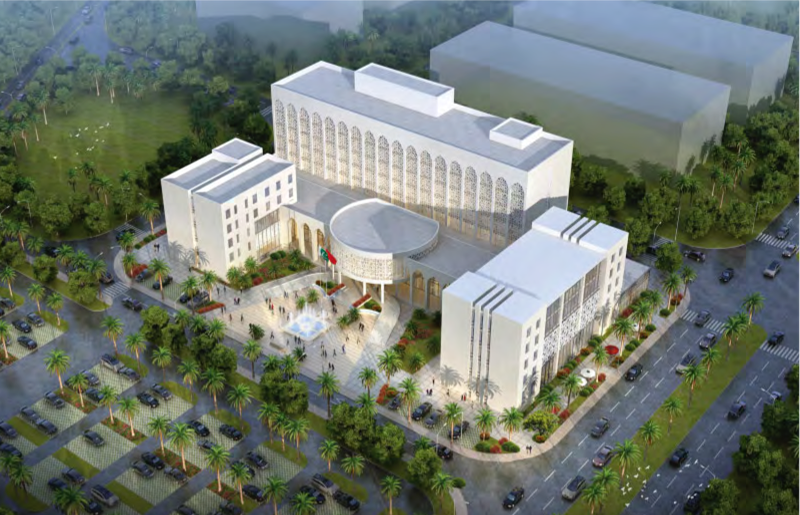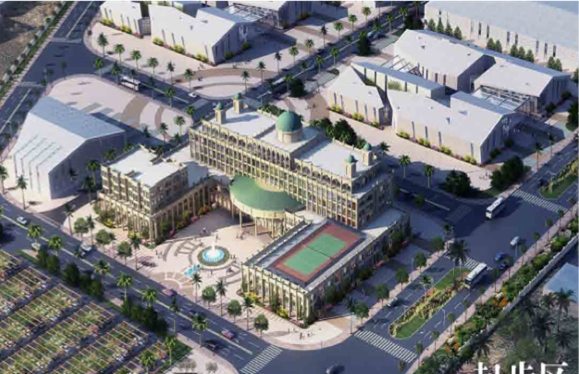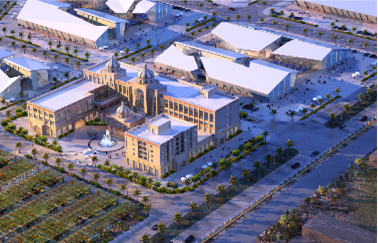Sohrab Ahmed Marri: BRI Architecture in Pakistan
China's Architectural Cooperation in Pakistan
through the BRI
Sohrab Ahmed Marri

Figure 1: The first design proposal of Gwadar Free Zone Business Center Source: Image by Wang Qian
Few writings deal with the architectural cooperation between China and the global south in the context of the BRI. [1] Much literature highlights the North-South relations in architecture and urban planning from colonial times to the post-war period, and also the current contemporary period of globalization. [2] The BRI, with regard to geopolitics, economic trade, and international politics, presents new East–South relations. This incites curiosity about how the architectural exchanges and cooperations are different. The question is difficult to answer; however, it leads us at least to rethink some aspects such as “transcultural architecture” (Botz-Bornstein 2016), “respect of otherness” (Akcan 2016), and the “clash of cosmopolitanism vs. localism” (King 2004). One also needs to consider insights from case studies.
What are Chinese architects exporting? China has received Western architecture models which were translated into a Chinese context, and now it is exporting architecture to the Global South. Any center-periphery theory does not work here.
The new silk road is inspired by the concept of the old silk road as it promotes harmonious architecture, culture, and knowledge exchanges. The BRI model involves government-to-government cooperation, and architectural knowledge flows under mutually established guidelines and surveillance and encourages the inclusion of local voices in architecture (Marri 2021).
The Gwadar Business Center
The Gwadar Port and Free Zone is the core project of China Pakistan Economic Corridor. It is being developed by Chinese state owned companies. The Gwadar Business Center of the Free Zone is a monumental project financed, designed and constructed by CCCC (China Communication and Construction Company) Ltd. It is a comprehensive service center with offices, accommodation, catering, leisure, and security facilities. The target customer groups are Chinese customers going to Gwadar for business, but the center will also facilitate Pakistani and other international customers. [3]

Figure 2: Green Domes series of arches, the second design proposal of Gwadar Free Zone Business Center Source:Image from COPHC office.
Several architectural design proposals were made and discussed with a local working group comprising project managers, politicians, economists, engineers, planners, and architects. The technical working group of China mostly comprised representatives from the Ministry of Commerce (MOFCOM) and the architects, engineers, and project managers from Chinese construction companies. Their interaction creates a ‘contact zone’ (Pratt 1991) between the two cultures. The contact zone initiates dialogue in the architectural exchanges of knowledge regarding different interests, movement of ideas, and construction methodologies.

Figure 3: The modified and final version of GBC models source: COPHC office Gwadar
In this ‘contact zone’, the final design was repeatedly improved through discussions with the help of local experts. For instance, one proposal consisted of more arches and domes, with the latter colored in green. The designers probably thought to have expressed the local sentiment because green is the color of the flag of Pakistan. However, these green domes represent specific sects of Muslims in Pakistan and are mostly used in mosques, making the suggested approach irrational. Thus, in the final design, the green domes were omitted, and the number of arches and domes were reduced to give it a more contemporary outlook. A beige and brown color scheme that resembles the Gwadar vernacular mud architecture was used.
This eclectic architecture of the Gwadar Business Center is held in regard by the local people as it will enhance the image of Gwadar and bring prosperity. The architecture projects under the BRI are not merely architectural exports from China but also cross-cultural exchanges. Chinese architects negotiated their professional practice to follow the guidelines of the Chinese state authorities as well as the guidelines, expectations, and suggestions of the local state authorities.
Notes
1. Sohrab Ahmed Marri, “Transnational Global Infrastructure Spaces and Their Impact on Historical Places: Resistance, Negotiation and Alternatives in the Case of Gwadar,” in Cities’ Vocabularies: The Influences and Formations (Springer, 2021), 325–39; Sohrab Ahmed Marri et al., “Fondazione Italia Cina,” Mondo Cinese, 2019; Sohrab Ahmed Marri, “Architecture for ‘Other’. China’s Eclectic Pragmatism in Developing Countries within the Framework of the Belt and Road Initiative” (Doctoral Thesis, Politecnico di Torino, 2021), https://iris.polito.it/handle/11583/2912970#.YeKBIVhBzq0.
2. See Avermaete 2015 and 2017, King 2004, Moreira 2019; Lu 2007; Akcan 2016; Stanek 2012 and 2020.
3. Marri; Wang 王倩 Qian, “瓜达尔自由区商务中心——巴基斯坦项目设计 (Gwadar Free Zone Business Center-Pakistan Project Design),” 建筑与文化 (Architecture and Culture) 0, no. 4 (2016): 48–51.
Bibliography:
Avermaete, Tom et al., “Crossing Boundaries,” Oase: Tijdschrift Voor Architectuur 95 (2015): 3–7.
Avermaete, Tom. Global Modernism with Tom Avermaete, in Architecture Talk 12, 2017 https://www.architecturetalk.org/home/12.
Botz-Bornstein, Thorsten, Transcultural Architecture: The Limits and Opportunities of Critical Regionalism (Routledge, 2016).
Esra Akcan, “Postcolonial Theories in Architecture,” in A Critical History of Contemporary Architecture (Routledge, 2016), 143–64.
King, Anthony Spaces of Global Cultures: Architecture, Urbanism, Identity (Routledge, 2004).
Lu, Duanfang, “Third World Modernism: Utopia, Modernity, and the People’s Commune in China,” Journal of Architectural Education 60, no. 3 (2007): 40–48.
Łukasz Stanek, “Introduction: The ‘Second World’s’ Architecture and Planning in the ‘Third World,’” The Journal of Architecture 17, no. 3 (2012): 299–307.
Łukasz Stanek, Architecture in Global Socialism: Eastern Europe, West Africa, and the Middle East in the Cold War (Princeton University Press, 2020).
Marri, Sohrab, “Architecture for ‘Other’. China’s Eclectic Pragmatism in Developing Countries within the Framework of the Belt and Road Initiative.” Thesis Politecnico Torino, 2021.
Moreira, Paulo “Colonial Modern. Aesthetics of the Past–Rebellions for the Future, by Tom Avermaete, Serhat Karakayali and Marion Von Osten,” Estudo Prévio-Revista Do Centro de Estudos de Arquitectura, Cidade e Território 15 (2019);
Pratt, Mary Louise, “Arts of the Contact Zone,” Profession, 1991, 33–40.
 Sohrab Ahmed Marri received his PhD in Architecture from Politecnico di Torino in 2021. His thesis was about Chinese architectural cooperation in developing countries in context of BRI.
Sohrab Ahmed Marri received his PhD in Architecture from Politecnico di Torino in 2021. His thesis was about Chinese architectural cooperation in developing countries in context of BRI.
.

